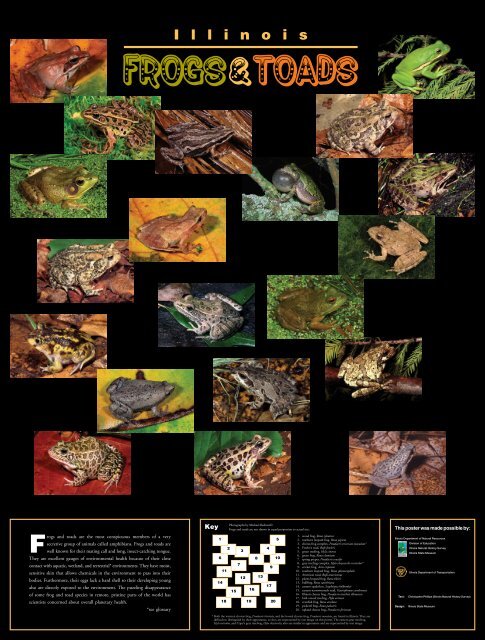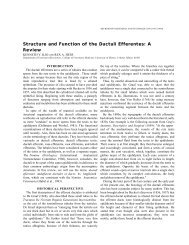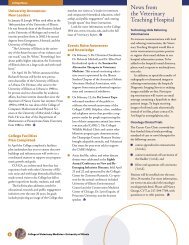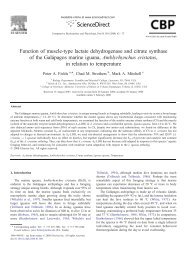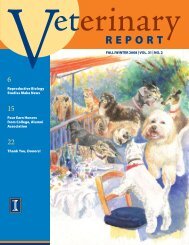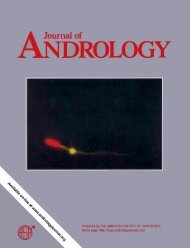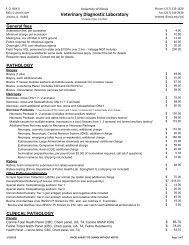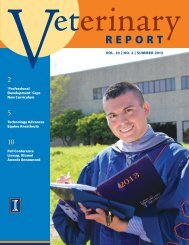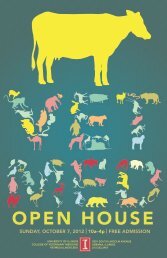Illinois Frogs And Toads Poster
Illinois Frogs And Toads Poster
Illinois Frogs And Toads Poster
Create successful ePaper yourself
Turn your PDF publications into a flip-book with our unique Google optimized e-Paper software.
I l l i n o i s<br />
<strong>Frogs</strong> & <strong>Toads</strong><br />
<strong>Frogs</strong> and toads are the most conspicuous members of a very<br />
secretive group of animals called amphibians. <strong>Frogs</strong> and toads are<br />
well known for their mating call and long, insect-catching tongue.<br />
They are excellent gauges of environmental health because of their close<br />
contact with aquatic, wetland, and terrestrial* environments. They have moist,<br />
sensitive skin that allows chemicals in the environment to pass into their<br />
bodies. Furthermore, their eggs lack a hard shell so their developing young<br />
also are directly exposed to the environment. The puzzling disappearance<br />
of some frog and toad species in remote, pristine parts of the world has<br />
scientists concerned about overall planetary health.<br />
*see glossary<br />
Key<br />
1<br />
6<br />
14<br />
11<br />
Photographs by Michael Redmer©.<br />
<strong>Frogs</strong> and toads are not shown in equal proportion to actual size.<br />
2<br />
15<br />
7<br />
3<br />
12 13<br />
16<br />
4<br />
5<br />
8 10<br />
9<br />
17<br />
18 19 20<br />
1. wood frog, Rana sylvatica<br />
2. northern leopard frog, Rana pipiens<br />
3. chorus frog complex, Pseudacris triseriata-maculata*<br />
4. Fowler’s toad, Bufo fowleri<br />
5. green treefrog, Hyla cinerea<br />
6. green frog, Rana clamitans<br />
7. spring peeper, Pseudacris crucifer<br />
8. gray treefrog complex, Hyla chrysoscelis-versicolor*<br />
9. cricket frog, Acris crepitans<br />
10. southern leopard frog, Rana sphenocephala<br />
11. American toad, Bufo americanus<br />
12. plains leopard frog, Rana blairi<br />
13. bullfrog, Rana catesbeiana<br />
14. eastern spadefoot, Scaphiopus holbrookii<br />
15. eastern narrowmouth toad, Gastrophryne carolinensis<br />
16. <strong>Illinois</strong> chorus frog, Pseudacris streckeri illinoensis<br />
17. bird‐voiced treefrog, Hyla avivoca<br />
18. crawfish frog, Rana areolata<br />
19. pickerel frog, Rana palustris<br />
20. upland chorus frog, Pseudacris feriarum<br />
* Both the western chorus frog, Pseudacris triseriata, and the boreal chorus frog, Pseudacris maculata, are found in <strong>Illinois</strong>. They are<br />
difficult to distinguish by their appearance, so they are represented by one image on this poster. The eastern gray treefrog,<br />
Hyla versicolor, and Cope’s gray treefrog, Hyla chrysoscelis, also are similar in appearance and are represented by one image.<br />
This poster was made possible by:<br />
<strong>Illinois</strong> Department of Natural Resources<br />
Division of Education<br />
<strong>Illinois</strong> Natural History Survey<br />
<strong>Illinois</strong> State Museum<br />
<strong>Illinois</strong> Department of Transportation<br />
Text: Christopher Phillips (<strong>Illinois</strong> Natural History Survey)<br />
Design: <strong>Illinois</strong> State Museum
Anatomy<br />
Life History<br />
Frog Calls<br />
EYELID<br />
DORSOLATERAL FOLD<br />
EYE<br />
TYMPANUM<br />
FEMUR<br />
FOOT<br />
TIBIA<br />
Illustration from Smith, 1961<br />
TARSUS<br />
F<br />
rogs and toads are the only members of the Phylum Chordata, Class Amphibia, and Order Anura.<br />
Unlike tadpoles, adults do not have a tail. Adult frogs and toads have a squat posture and strong rear legs,<br />
which give them the ability to jump long distances. Their long, retractable tongue is used to catch their<br />
main food item, insects.<br />
The tympanic membrane, or tympanum, aids the process of hearing. This circular structure, located on<br />
each side of the head behind the eyes, picks up vibrations in air or water and passes them to the inner ear.<br />
<strong>Frogs</strong> and toads breathe through their lungs like most terrestrial vertebrates, but they also utilize their soft,<br />
moist skin as a secondary means of taking in oxygen. This type of breathing requires that the skin be both<br />
moist and permeable. Their skin remains permeable because they do not have a protective covering like scales,<br />
hair, or feathers. They maintain moisture through mucous gland secretions and by staying near water. <strong>Toads</strong><br />
have a somewhat more watertight skin than frogs and can therefore venture farther from water.<br />
<strong>Toads</strong> are also characterized by the horny bumps, sometimes called warts, on their skin. The most pronounced<br />
of these bumps, called parotoid glands, are found just behind the toad’s eyes and produce a poison<br />
that helps in defense against predators. The poison repels animals as large as raccoons because of the mild<br />
mouth discomfort they experience when trying to eat a toad. Often they drop the toad, allowing its escape.<br />
2<br />
3<br />
1<br />
4<br />
5<br />
Illustrations by Mark Sabaj, <strong>Illinois</strong> Natural History Survey<br />
All <strong>Illinois</strong> frogs and toads have a complex, biphasic life cycle. Adults are aquatic, semi-aquatic, or<br />
terrestrial, but all species lay their eggs in water. During the breeding season, which may start as early as<br />
February in <strong>Illinois</strong>, males congregate at wetlands and begin chorusing. The males’ calls attract females<br />
to the wetlands, and soon males and females are paired in amplexus (1). Amplexus ends with fertilization: the<br />
female expels her eggs into the water, and the male immediately covers them with sperm.<br />
A gelatinous coating usually covers anuran eggs (2), which may be laid singly, in sheets, strings, or globs,<br />
depending on the species. Some species’ eggs are attached to sticks or leaves; others simply float freely in the<br />
water. Fertilized eggs develop and hatch into free-swimming larvae, or tadpoles (3 & 4), within a few days.<br />
Tadpoles have a horny, beaklike mouth designed for scraping algae, and they begin feeding almost immediately<br />
after hatching. A few weeks later, hind limbs appear (5), and within a month or two the tadpoles have<br />
undergone metamorphosis. Except for a temporary tail stub, the newly transformed froglets look much like<br />
the adults. They usually leave the water and take up existence on land until cold weather prompts them to<br />
seek out a safe place, such as the muddy bottom of a pond, for hibernation.<br />
Although the larvae are herbivorous, all adult frogs and toads in <strong>Illinois</strong> are carnivorous. The most common<br />
food items are flying insects, such as flies and mosquitoes. Although adults are primarily nocturnal, they<br />
may be seen or heard during the day, especially if the weather is overcast or rainy.<br />
Animals produce sounds for a variety of reasons,<br />
but the primary function of vocalization is 7<br />
eastern gray<br />
announcing the presence of one individual 6<br />
treefrog<br />
to others of the same species. <strong>Frogs</strong> and toads have<br />
well-developed voices that are used to attract mates,<br />
proclaim feeding territories, and signal alarm. Of these<br />
functions, the mating calls of the males are probably<br />
the most familiar to us. Just as in birds, each species<br />
5<br />
4<br />
3<br />
2<br />
1<br />
of frog or toad has a unique mating song, and biologists<br />
can identify an individual species by its call alone.<br />
Anurans produce sounds in a manner similar to that<br />
0.1 .2 .3 .4 .5 .6 .7 .8 .9 1.0<br />
TIME (Seconds)<br />
of most other vertebrates, by passing air over the vocal<br />
cords. <strong>Frogs</strong> and toads take the process a step further by<br />
using the vocal sac—loose skin usually located under<br />
the lower jaw—to resonate or amplify the sound. Both<br />
males and females possess functional vocal cords, but<br />
they are better developed in males. Only males have<br />
vocal sacs, which accounts for the difference in sound<br />
production between the sexes.<br />
Frog calls can be “described” in scientific terms<br />
by playing a recording of a call through an electronic<br />
sound analyzer. The resulting graph, called a sonogram,<br />
7<br />
6<br />
5<br />
4<br />
3<br />
2<br />
1<br />
Cope’s gray treefrog<br />
0.1 .2 .3 .4 .5 .6 .7 .8 .9 1.0<br />
TIME (Seconds)<br />
is a visual representation of the call. Scientists<br />
use sonograms to identify species whose calls cannot<br />
The vertical axis (y) represents the pitch, and the horizontal<br />
axis (x) represents time, usually seconds.<br />
be distinguished with the human ear. For this reason,<br />
sonograms are used to distinguish between the two species of gray treefrog that occur in <strong>Illinois</strong>. The eastern<br />
gray treefrog, Hyla versicolor, and Cope’s gray treefrog, Hyla chrysoscelis, are identical in outward appearance<br />
and were considered to be of the same species until biologists detected differences in their mating calls. Sonograms<br />
of the two mating calls show that the call of Cope’s gray treefrog has a higher pitch and more pulses<br />
per second than that of the eastern gray treefrog. However, the differences that appear obvious in the sound<br />
analysis are actually very subtle in nature and can be picked up only by a trained ear.<br />
KHz<br />
KHz<br />
Conservation<br />
I l l i n o i s<br />
Glossary<br />
Amplexus<br />
the mating clasp of frogs and toads; the male holds the female from<br />
behind with his forelegs firmly around her chest<br />
Anuran<br />
member of the vertebrate order Anura, characterized by lack of a tail,<br />
moist skin, and long hind legs adapted for leaping: a frog or toad<br />
Biphasic<br />
two distinct phases; usually refers to a life cycle that has a land and a<br />
water portion<br />
<strong>Frogs</strong><br />
Carnivorous<br />
Dorsolateral Fold<br />
Endocrine<br />
having a diet that includes mainly animals<br />
a line of raised skin along each side of the back (see Anatomy<br />
illustration)<br />
ductless glands and their regulatory products<br />
Heavy Metals<br />
potentially poisonous metals such as lead, mercury, and cadmium<br />
Cricket frog (Acris crepitans), from Slime, Scales and Mudpuppy Tails, 1997,<br />
<strong>Illinois</strong> Department of Natural Resources, Office of Public Services, Division<br />
of Education, Springfield<br />
Over the last few years there has been increased concern about worldwide population declines<br />
and even extinctions of frog and toad species. Habitat destruction and degradation are clearly<br />
responsible in some cases, but the most alarming declines have occurred in relatively pristine<br />
environments such as the rainforests of eastern Australia and the cloud forests of Costa Rica. Closer to<br />
home, biologists in the upper Midwest have been noticing the disappearance of our smallest frog, the<br />
cricket frog (Acris crepitans). Until the early 1980s, cricket frogs were among the most common anurans<br />
in <strong>Illinois</strong>, and they could be found in almost every county. Recently, biologists have noticed a decline in<br />
the number of cricket frog populations in the Chicago region but not downstate. Among the causes that<br />
have been suggested for this decline is build-up of toxic substances (pesticides, heavy metals) in the frogs’<br />
breeding ponds, leading to endocrine disruption. A survey of museum specimens collected in <strong>Illinois</strong> over<br />
the past 100 years showed that more frogs from the Chicago region displayed anatomical signs of endocrine<br />
disruption compared to the rest of the state. In the heavily industrial and urban landscape of the Chicago<br />
region, habitat destruction and fragmentation are also likely involved.<br />
&<br />
<strong>Toads</strong><br />
Herbivorous<br />
Larva<br />
Metamorphosis<br />
Mucous Gland Secretion<br />
Nocturnal<br />
Parotoid Glands<br />
Snout-to-Vent Length<br />
Terrestrial<br />
Tympanum<br />
having a diet that includes mainly plants<br />
(pl. larvae) the newly hatched, immature form of an animal that undergoes<br />
metamorphosis, differing markedly in form and appearance<br />
from the adult<br />
a marked change in the form or structure of an animal occurring after<br />
birth or hatching<br />
clear watery liquid that is secreted onto the skin of amphibians<br />
through small pores distributed over the body surface<br />
active primarily at night<br />
paired, wartlike glands in the skin of toads; located behind the eyes or<br />
in the neck and shoulders<br />
the distance from the tip of the snout to the excretory opening; the<br />
standard measurement for frogs and toads<br />
land based, or living on land<br />
(tympanic membrane) the externally visible part of the eardrum in<br />
most frogs and toads (see Anatomy illustration)<br />
Vertebrate<br />
animal with a backbone<br />
Frog & Toad Facts<br />
Bibliography<br />
Agency Resources<br />
<strong>Frogs</strong> and toads do not cause warts.<br />
The largest <strong>Illinois</strong> anuran is the bullfrog, Rana catesbeiana, which can attain a snout-tovent<br />
length of 15 cm (6 inches).<br />
The smallest <strong>Illinois</strong> anuran is the cricket frog, Acris crepitans, which averages 2 cm<br />
(1 inch) snout-to-vent length.<br />
The average frog can leap a distance equal to ten times its body length.<br />
Most burrowing frogs dig with their hind legs, but the <strong>Illinois</strong> chorus frog, Pseudacris<br />
streckeri illinoensis, is one of only a few burrowing species that digs with its front legs.<br />
The diet of the eastern narrowmouth toad, Gastrophryne carolinensis, consists almost<br />
exclusively of ants.<br />
The long tongue of frogs and toads is folded in half when stored in the mouth. When<br />
extended for capturing prey, the tongue unfolds and is “flipped” out rather than being cast<br />
out straight.<br />
The <strong>Illinois</strong> chorus frog, Pseudacris streckeri illinoensis, can hunt for food while it is<br />
underground. It probably eats a variety of insect larvae, such as cutworms (moth larvae),<br />
that it finds in its sandy burrows.<br />
Bullfrogs, Rana catesbeiana, are famous for their incredible eating habits. They will<br />
attempt to eat anything that moves—that they can at least partially swallow. They have<br />
been known to eat baby ducks, small mammals, other bullfrogs, and snakes.<br />
The treefrogs of <strong>Illinois</strong> have a sticky cup at the end of each toe that allows them to climb<br />
vertical surfaces such as windows and tree trunks. Treefrogs may be found in branches<br />
more than fifty feet off the ground.<br />
A female bullfrog, Rana catesbeiana, can lay over 20,000 eggs in a thin film measuring two<br />
feet by two feet.<br />
Some <strong>Illinois</strong> frogs, such as the wood frog, Rana sylvatica, accumulate glycerol in their<br />
body tissues. The glycerol acts as an antifreeze, allowing them to survive subfreezing<br />
temperatures.<br />
Behler, J.L., and F.W. King. 1979. The<br />
Audubon Society field guide to<br />
North American reptiles and<br />
amphibians. Alfred A. Knopf,<br />
New York. 719 pp.<br />
Conant, R., and J.T. Collins. 1991.<br />
Reptiles and amphibians of eastern/<br />
central North America. Houghton<br />
Mifflin Company, Boston.<br />
450 pp.<br />
Dickerson, M.C. 1907. The frog book:<br />
North American toads and frogs<br />
with a study of the habits and life<br />
histories of those of the northeastern<br />
United States. Doubleday, Page<br />
and Co., New York. 253 pp.<br />
Duellman, W.E., and L. Treub. 1986.<br />
Biology of amphibians. McGraw-<br />
Hill, Inc., New York. 670 pp.<br />
Halliday, T., and K. Adler (editors). 1986.<br />
The encyclopedia of reptiles and<br />
amphibians. Facts on File Inc.,<br />
New York. 143 pp.<br />
Herkert, J.R., editor. 1992. Endangered<br />
and threatened species of <strong>Illinois</strong>:<br />
Status and distribution. Vol. 2,<br />
Animals. <strong>Illinois</strong> Endangered<br />
Species Protection Board,<br />
Springfield. 142 pp.<br />
Johnson, T.R. 2000. The amphibians and<br />
reptiles of Missouri. Department<br />
of Conservation, Jefferson City,<br />
Missouri. 400 pp.<br />
Parmalee, P. A. 1954. Amphibians of<br />
<strong>Illinois</strong>. Story of <strong>Illinois</strong>, no.<br />
10. <strong>Illinois</strong> State Museum,<br />
Springfield. 38 pp.<br />
Phillips, C.A., R.A. Brandon, and<br />
E.O. Moll. 1999. Field guide to<br />
amphibians and reptiles of <strong>Illinois</strong>.<br />
<strong>Illinois</strong> Department of Natural<br />
Resources, <strong>Illinois</strong> Natural<br />
History Survey, Champaign,<br />
<strong>Illinois</strong>. Manual 8. 282 pp.<br />
Smith, P.W. 1961. The amphibians and<br />
reptiles of <strong>Illinois</strong>. <strong>Illinois</strong> Natural<br />
History Survey Bulletin 28: 1298.<br />
Vogt, R.C. 1981. Natural history of<br />
the amphibians and reptiles of<br />
Wisconsin. The Milwaukee Public<br />
Museum, Milwaukee. 205 pp.<br />
Wright, A.H., and A.A. Wright. 1949.<br />
Handbook of frogs and toads.<br />
Comstock Publishing Co., Ithaca,<br />
New York. 640 pp.<br />
The <strong>Illinois</strong> Department of Natural Resources (IDNR) offers a variety of information<br />
about frogs and toads. The Division of Fisheries Resources regulates the harvest of frogs for<br />
game purposes. The <strong>Illinois</strong> Natural History Survey studies frog and toad distributions and<br />
population levels and maintains a research collection of anurans. The IDNR Division of<br />
Education provides aquatic-related educational materials for teachers, including the Aquatic<br />
<strong>Illinois</strong> and Biodiversity of <strong>Illinois</strong>, Volume I: Aquatic Habitats CD-ROMs. Wetland kits from the<br />
Education Section of the <strong>Illinois</strong> State Museum are available for loan at locations statewide.<br />
Division of Education<br />
<strong>Illinois</strong> Department of Natural Resources<br />
One Natural Resources Way<br />
Springfield, IL 62702-1271<br />
217-524-4126<br />
http://dnr.state.il.us<br />
dnr.teachkids@illinois.gov<br />
Division of Fisheries Resources<br />
One Natural Resources Way<br />
Springfield, IL 62702-1271<br />
217-782-6424<br />
http://dnr.state.il.us<br />
<strong>Illinois</strong> Natural History Survey<br />
1816 South Oak Street<br />
Champaign, IL 61820<br />
217-333-6880<br />
http://www.inhs.uiuc.edu<br />
<strong>Illinois</strong> State Museum<br />
Education Section<br />
502 South Spring Street<br />
Springfield, IL 62706-5000<br />
217-782-5993<br />
http://museum.state.il.us<br />
Equal opportunity to participate in programs of the <strong>Illinois</strong> Department of Natural Resources (IDNR) and those funded by the U.S.<br />
Fish and Wildlife Service and other agencies is available to all individuals regardless of race, sex, national origin, disability, age,<br />
religion or other non-merit factors. If you believe you have been discriminated against, contact the funding source’s civil rights<br />
office and/or the Equal Employment Opportunity Officer, IDNR, One Natural Resources Way, Springfield, IL 62702-1271; 217/785-<br />
0067; TTY 217/782-9175. This information may be provided in an alternative format if required. Contact the DNR Clearinghouse at<br />
217/782-7498 for assistance.<br />
Printed by the Authority of the State of <strong>Illinois</strong> IISG 08-674 10M 03/08


